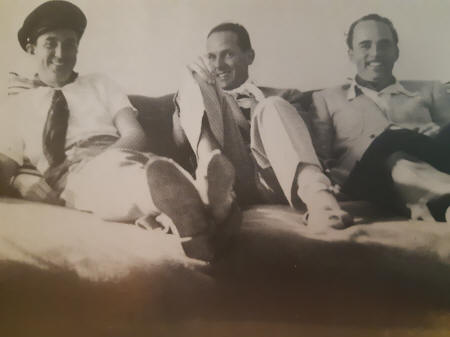

Queer Places:
4416 The Strand, Manhattan Beach, CA 90266
 Jack D. Moore (April 15, 1906 – December 29, 1998) was an American set decorator. He won an Academy Award (Little Women (1949)) and was nominated six times in the category Best Art Direction (Random Harvest (1942),
Sweet Charity (1969),
Young Bess (1953),
The Story of Three Loves (1953),
Sweet Charity (1969),
Airport (1970)).[1]
Jack D. Moore (April 15, 1906 – December 29, 1998) was an American set decorator. He won an Academy Award (Little Women (1949)) and was nominated six times in the category Best Art Direction (Random Harvest (1942),
Sweet Charity (1969),
Young Bess (1953),
The Story of Three Loves (1953),
Sweet Charity (1969),
Airport (1970)).[1]
A store window brough Jack Moore to Ed Willis' attention. But Moore was content with his job at H.T. Lockwood in Los Angeles, and at first turned down Willis' offer of employment. He only agreed after the persistent property chied doubled the salary. Like Richard Pefferle, Moore was on Ohio boy, but from an upper-middle-class Toledo family.
Jack D. Moore began working in film in 1933 as a set decorator, with close to a hundred credits to his name before making his debut as a full production designer in 1953 with The Story of Three Loves.
Considering the work of classic Hollywood's gay directors and gay producers, a small but vital subset of the studio system, suggests "queer cinema" might not be such a modern postulate. Occasionally, a convergence of director, producer, writer, and star came together, such as happened with Camille (1937). The gay writer DeWitt Bodeen said that Camille "represents a meeting of talents that were perfect for its interpretation." In fact, wags like to call the picture a rare "all-gay" studio production, and in some ways it comes close: producer David Lewis, director George Cukor, screenwriter Zoe Akins. Greta Garbo, too, and Mercedes de Acosta had a hand in the early draft of the script before Akins took over. Robert Taylor, who played a stunningly beautiful Armand, was rumored to be having an affair with the film's set decorator, Jack Moore. There was also Adrian on costumes and Sydney Guilaroff doing hair. Rex O'Malley infused his Gaston with a natural feyness, a quality perhaps intended by Cukor and Akins, and another gay actor, Rex Evans, played several bit parts. ("Who is that big man and what part is he playing?" Garbo asked Cukor. "That man is Rex Evans," the director replied, "and he's playing the part of a friend who needs a job.") Cukor also manuevered the hiring of another friend, and another gay man, as the picture's true art director, supplanting the ubiquitous Cedric Gibbons, whose contract nonetheless decreed screen credit. This was Oliver Messel, esteemed scenic and costume designer from the London stage, whose outsider status evoked suspicion in the competitive world of the Hollywood studios. It wasn't Messel's first encounter with the studio bureaucracy; in 1935, during the filming of Romeo and Juliet, Cukor had caused a near war by insisting Messel design the costumes instead of Adrian, whom Cukor, according to several friends, viewed as pompous and pretentious. Cukor, as discreet as he was, never tried to obfuscate either his Jewishness or his gayness in the way Adrian did. "I get annoyed with statements that call George "closeted",", said his longtime friend and Los Angeles Times film critic Kevin Thomas. "George was never closeted. He never pretended to be anything he wasn't. He lived according to the rules of his time, that's all."
For Conquest (1937), with Greta Garbo and Charles Boyer, Jack Moore decorated the set of the chateau where Napoleon's troops come charging through the great hall and leap over a grand piano. Rather than damage the authentic Aubuisson carpet he'd installed, Moore sewed together dozens of cocomats for that one scene, painting the finished product with the exact design of the carpet.
The design and execution of the 1939's classic The Wizard of Oz was the work of gay hands. The MGM prop department was presided over by a group of remarkable men, all gay, from the chief, Edwin Willis, through the talended decorators: Richard Pefferle, Jack Moore, Keogh Gleason, Henry Grace, and many others. Jack Moore died the poppy field for The Wizard of Oz, combining three soundstages to give the illusion of poppies stretching for miles.
"Jack Moore truly enjoyed his success," Frank Lysinger remembered. "His apartment was very stylish. He always insisted on having a houseman. Dick and Keogh used to tease him about it." His lavish parties, thrown with Jacques Mapes, a fellow decorator who worked briefly at MGM (he did Singin' in the Rain), became well known.
Property chief Edwin Willis was viewed as somewhat arrogant and aloof by his staff, even a bit sadistic, canceling vacations cavalierly at the last minute. His homosexuality was known, but there was little fraternization. Among the rest of them, however, there was a very real brotherhood. "Henry Grace, Jack Moore, Dick Pefferle, and Keogh Gleason shared an office, each with their own desk," Frank Lysinger recalled. "There was always a lot of carrying on. Jack and Henry also shared a house down in Manhattan Beach where they'd have some pretty wild weekends."
He died of natural causes in 1998, at the age of 92.
My published books: